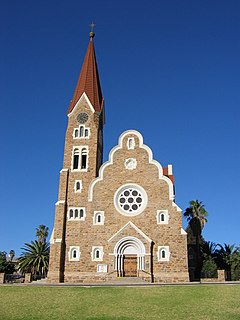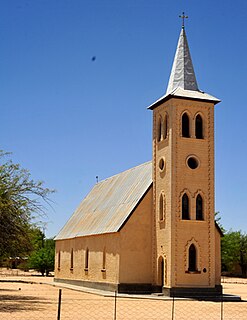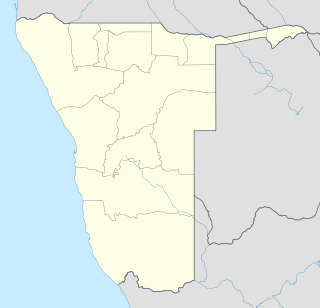The history of Namibia has passed through several distinct stages from being colonised in the late nineteenth century to Namibia's independence on 21 March 1990.

Windhoek is the capital and largest city of Namibia. It is located in central Namibia in the Khomas Highland plateau area, at around 1,700 metres (5,600 ft) above sea level, almost exactly at the country's geographical centre. The population of Windhoek in 2020 was 431,000 which is growing continually due to an influx from all over Namibia.

Karibib is a town in the Erongo Region of western Namibia. It has 3,800 inhabitants and owns 97 square kilometres (37 sq mi) of town land. Karibib is the district capital of the Karibib electoral constituency. It is situated on the Khan River, halfway between Windhoek and Swakopmund on the B2, the main road between the Walvis Bay and Johannesburg. The town is known for its aragonite marble quarries and the Navachab Gold Mine.

The Popular Democratic Movement (PDM), formerly the Democratic Turnhalle Alliance (DTA), is an amalgamation of political parties in Namibia, registered as one singular party for representation purposes. In coalition with the United Democratic Front, it formed the official opposition in Parliament until the parliamentary elections in 2009. The party currently holds 16 seats in the Namibian National Assembly and one seat in the Namibian National Council and is the official opposition. McHenry Venaani is president of the PDM.

The National Unity Democratic Organisation (NUDO) is a political party in Namibia. It has been represented in the National Assembly of Namibia and in the National Council of Namibia since it split from the Democratic Turnhalle Alliance prior to the 2004 general and local elections. The party's president is Esther Muinjangue.

Hendrik Witbooi was a chief of the ǀKhowesin people, a sub-tribe of the Khoikhoi. He lived in present-day Namibia. Witbooi is regarded as one of the national heroes of Namibia. His face is portrayed on the obverse of all N$50, N$100 and N$200 Namibian dollar banknotes.

The National Council is the upper chamber of Namibia's bicameral Parliament. It reviews bills passed by the lower chamber and makes recommendations for legislation of regional concern to the lower chamber.

The Christ Church is a historic landmark and Lutheran church in Windhoek, Namibia, belonging to the German-speaking Evangelical Lutheran Church in Namibia. It was designed by architect Gottlieb Redecker.

Otjimbingwe is a settlement in the Erongo Region of central Namibia. It has approximately 8,000 inhabitants.

Kuaima Isaac Riruako was a Namibian politician and the paramount chief of the Herero people. He served as a National Unity Democratic Organisation (NUDO) representative in Parliament, and he was the President of NUDO and its presidential candidate in the 2004 presidential election, placing fourth with 4.23% of the national vote.

Chief Hosea Komombumbi Kutako, was an early Namibian nationalist leader and a founder member of Namibia's first nationalist party, the South West African National Union (SWANU).

The Heroes' Acre is an official war memorial of the Republic of Namibia. Built into the uninhabited hills 10 kilometres (6 mi) south of the city centre of Windhoek, Heroes' Acre opened on 26 August 2002. It was created to "foster a spirit of patriotism and nationalism, and to pass [this] to the future generations of Namibia".
Heroes' Day is a national public holiday in Namibia. It is recognized by the United Nations as Namibia Day. Celebrated annually on the 26th of August, the day commemorates the Namibian War of Independence which began on 26 August 1966 at Omugulugwombashe.

Parliament Gardens is a small park in downtown Windhoek, Namibia. It is located between the Tintenpalast and the Christuskirche. It was laid out in 1932 and was originally called the Tintenpalast gardens, adopting its present name after Namibian independence in 1990.
Gottlieb Wilhelm Eduard Redecker was a German engineer and architect in South West Africa. He was responsible for a number of important buildings which still stand today in Namibia, particularly in Windhoek, including the national assembly building, the Tintenpalast.

German South West Africa was a colony of the German Empire from 1884 until 1915, though Germany did not officially recognise its loss of this territory until the 1919 Treaty of Versailles. With a total area of 835,100 km², it was one and a half times the size of the mainland German Empire in Europe at the time. The colony had a population of around 2,600 Germans.

Seeis is a small settlement in the Khomas Region of central Namibia. It is situated on the B6 national road 11 km (6.8 mi) east of Hosea Kutako International Airport on the turnoff of the dirt road D1458. The Seeis Rivier, an ephemeral river, cuts the settlement. Seeis is a railway stop on the Windhoek - Gobabis railway line.

Aminuis is a cluster of small settlements in the remote eastern part of the Omaheke Region of Namibia, located about 500 km east of Windhoek. It is the district capital of the Aminuis electoral constituency.
The Augustineum Secondary School, established in 1866, is among the oldest schools in Namibia. Originally situated in Otjimbingwe, it was relocated to Okahandja in 1890, and finally to Windhoek in 1968. Previously also known as the Augustineum Training College and today the Augustineum Secondary School, it is a public school located in Khomasdal, a suburb of Windhoek.
















